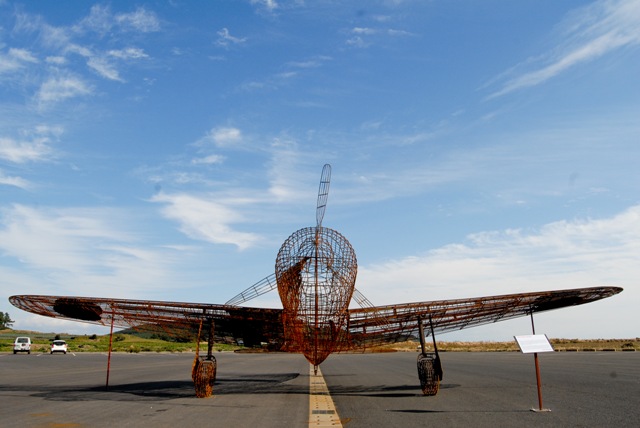| |
 |
|
| ▲ Photo courtesy Yang Ho-jun |
March 23, 2017 UPDATE HERE
The Air Force announced on March 9 that it plans to establish a base at Jeju’s second airport site in Seongsan-eup.
Speaking at the Jeju Aerospace Museum, Air Force Chief of Staff Jeong Gyeong-du confirmed that the military wants to locate the Southern Region Search and Rescue Air Group at the airport which is due for completion by 2025.
Southern Region SAR will comprise four planes, four helicopters and up to 300 Air Force personnel. The base is expected to cover a fifth (1-1.3 square kilometers) of the new airport area and it could be included in the next Mid-Term Defense Plan from 2021.
Chief of Staff Jeong said that “Jeju people have no need to feel anxious” and emphasized that SAR does not include fighter aircraft. Nevertheless, the Seoul Shinmun reported back in 2006 that an SAR base was the first stage in establishing an air defense squadron on Jeju.
The Air Force denies this and insists the plans are still in their infancy. “There has been absolutely no preliminary contact, nor any official consultation,” Air Force Director of Public Affairs Lee Sang-gyu told Headline Jeju, adding that a feasibility study will commence next year with full community consultation.
The Air Force SAR is headquartered at Cheongju International Airport and a Jeju base will give it wider coverage and faster response times when responding to boats and aircraft in distress across the south of the peninsula.
The Southern Region SAR was first included in the 2007-2011 Mid-Term Defense Plan and it was opposed by civil society groups from the outset. The Ministry of Defence abandoned its 2012 plan to use Altteureu Airfield in Daejeong-eup after public protests and insufficient runway length.
The Air Force announcement is embarrassing for the local government as it had insisted that the airport was solely for commercial use.
Civil society opposition is growing by the day. The Jeju Environmental Movement Union said in a March 6 statement that if Governor Won Hee-ryong is found to have any links to the Air Force plans, “it is obvious grounds for impeachment.”
On March 8, the JEMU stated that “All Jeju residents are angered” by the news. This was followed by a statement on March 12 from the Citizens’ Movement for a Review of the Second Airport and a New Jeju Island which criticized the military for “shamelessly reversing” its previous commitments.
Villagers surrounding the second airport site in Seongsan-eup were already engaged in a bitter fight to stop the airport, and the Citizens’ Movement echoed their vow to “resist the [Air Force] plan with their lives.”
Kang Wanbo, executive chairman of the Seongsan-eup Second Airport Opposition Committee, told The Jeju Weekly that the lies of the authorities were now being fully exposed.
“Opposition [to the second airport] among locals has furiously erupted. In the neighboring villages, too, the opposition ranks have swelled,” said Kang.
The Air Force revelations come at a sensitive time following the mainland deployment of the Terminal High Altitude Area Defense (THAAD) system in partnership with the US. The US insists the missile-defense system will protect the South from North Korean attack, but China insists that it is the real target for surveillance and containment.
In retaliation, Beijing ordered travel agencies to stop providing tours to Korea from March 15, and all Chinese cruises to Jeju from March 16 to June 30 were canceled. At Jeju port on March 13, 3,400 Chinese cruise passengers refused to disembark in protest, and some Chinese airlines have also stopped direct flights to the island.
The Air Force base at the second airport has no known link to the US or THAAD deployment, but a larger military presence on Jeju could further damage the resort island’s image among Chinese.
With a general election approaching on May 9, China hopes that an incoming liberal administration will reconsider the THAAD deployment. This is unlikely, however, and frontrunner Moon Jae-in has shied away from scuppering the US deal.
Anti-war campaigners see THAAD, Jeju Civilian-Military Complex Port and the proposed Air Force base as part of long-term US strategy in the region. Kang of the Seongsan-eup Second Airport Opposition Committee believes that the truth will be revealed in time.
“Although the Air Force is initially setting up a base for search and rescue missions, eventually it will become a battle squadron to secure US strategy in Northeast Asia. Because of this, the struggle at this stage is to stop the second airport itself,” said
Jeju’s hostility to a military presence is deep-rooted, as displayed in the bitter nine-year struggle to stop the construction of Jeju Civilian-Military Complex Port at Gangjeong.
Between 1947 and 1954, state forces (under official US command until August 15, 1948) killed up to 30,000, mostly innocent, islanders in the Jeju Massacre. In 2005, partly in recognition of this history, the island was designated an “Island of World Peace” by the Korean government.
Memories go further back still. Foreign powers have twice exploited the island’s strategic position. The Mongol Yuan Dynasty (1270-1356) used Jeju as a military garrison for invasions of Japan, and colonial Japan (1910-1945) used it as an air base for attacks on China.
Even now, the Island of World Peace is surrounded by a sea of troubles. China and Japan dispute sovereignty over the Senkaku/Diaoyu islands some 900 km to the south, while China, Japan and Korea all have overlapping continental shelf claims in the Okinawa Trough, some 750 km to the southeast.
There is also the small matter of a reef within Jeju Province itself; China disputes Korea’s sovereignty over Ieodo Islet (Socotra/Suyan Rock) which lies 149 km to the southwest.
Seoul clearly sees Jeju’s role as crucial in facing off the growing security challenges in East Asia. As the Korean saying goes, however, “When whales fight, the shrimp's back is broken,” and Jeju is a little shrimp in a deep blue ocean. |




















